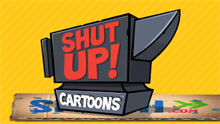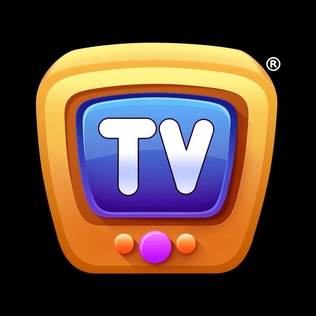
Unboxing is the process of unpacking consumer products, especially high-tech gadgets, which is recorded on video and shared online. The video typically includes a detailed description and demonstration of the product.

YouTube is an American online video sharing platform owned by Google. Accessible worldwide, it was launched on February 14, 2005, by Steve Chen, Chad Hurley, and Jawed Karim, three former employees of PayPal. Headquartered in San Bruno, California, United States, it is the second most visited website in the world, after Google Search. YouTube has more than 2.5 billion monthly users, who collectively watch more than one billion hours of videos every day. As of May 2019, videos were being uploaded to the platform at a rate of more than 500 hours of content per minute, and as of 2021, there were approximately 14 billion videos in total.

Shut Up! Cartoons was a YouTube animation channel project created by the Smosh duo and Barry Blumberg that features various animated videos. Shut Up! Cartoons launched on April 30, 2012, with Do's and Don'ts and ended with the termination of the series Smosh Babies on June 23, 2017.

Sad Satan is a horror video game released for Microsoft Windows in 2015. The game was allegedly created by a dark web user operating under the pseudonym "ZK".

ChuChu TV is a network of Indian YouTube channels that creates edutainment content for children from ages 1 to 6. The network offers animated 2D and 3D videos featuring traditional nursery rhymes, in English, Hindi, Tamil and other languages, as well as original children's songs. As of April 2024, ChuChu TV is the 13th most-subscribed channel on the platform YouTube.

YouTube Kids is a video app and website for children developed by YouTube, a subsidiary of Google. The app provides a version of the service oriented solely towards children, with curated selections of content, parental control features, and filtering of videos deemed inappropriate for viewing by children under the age of 13, in accordance with the Children's Online Privacy Protection Act, which prohibits the regular YouTube app from profiling children under the age of 13 for advertising purposes.
FamilyOFive, originally known as DaddyOFive, was a controversial YouTube channel and online alias of Michael Christopher "Mike" Martin, which focused on daily vlogging and "prank" videos. At its peak, the channel's videos featured Martin, his wife Heather Martin—also known by her online alias MommyOFive—and their children. In 2017, following a series of "prank" videos showing the parents physically and emotionally abusing their children, the channel became the center of a public controversy, as outrage grew over their mistreatment of their children.

Mother Goose Club is an educational nursery school program that streams on its eponymous YouTube channel and is produced by Sockeye Media LLC. Its YouTube channel has acquired more than 8 billion views and 7 million subscribers since 2009. Episodes of the program have also aired on PBS stations and are available on streaming platforms like Netflix, Amazon Prime Video, and Tubi. The show is made up of a series of educational live-action and animated segments, with a cast of six recurring characters who introduce classic nursery rhymes and other songs to children through catchy tunes, play, and interactive lessons.

Ryan's World is a children's YouTube channel for children aged 2–6 featuring Ryan Kaji along with his mother, father, and twin sisters.
Toy Freaks was a controversial Elsagate YouTube channel run by Gregory Chism, a single father of two living in Granite City, Illinois. The channel was known for its videos featuring Chism and his two daughters in a variety of disturbing or inhumane situations. It was created in 2012 and terminated by YouTube in November 2017. The channel has been described as one of the first channels brought to light with the Elsagate phenomenon.
"Johnny Johnny Yes Papa" is an English-language nursery rhyme. The song is about a child, Johnny, who is caught by his father eating sugar when he is not supposed to. Versions of this song comprising more than one verse usually continue with variations on this theme.
Cocomelon is an American YouTube channel owned by the British company Moonbug Entertainment and maintained by the American company Treasure Studio. Cocomelon specializes in 3D animation videos of both traditional nursery rhymes and their own original children's songs. As of April 2024, Cocomelon is the 3rd most-subscribed and 2nd most-viewed channel on YouTube.
Stevin W. John, better known by his alias Blippi, is an American children's entertainer on YouTube, Hulu, Netflix, HBO Max, Peacock and Amazon Prime Video. The Blippi character that John portrays has a childlike, energetic, and curious persona, and is always dressed in a blue and orange beanie cap, blue shirt, orange suspenders, and an orange bow tie. John later legally changed his name to Stevin W. John sometime before 2019.
PocketWatch, Inc. is a digital media studio that declares that its specialization is turning young stars on YouTube into global franchises. Its offices and studio are based in Culver City, California. The company was founded in 2012 by Chris M. Williams. It is funded by Third Wave Digital in addition to other investors and angels such as Jon Landau, UTA Ventures, the venture arm of United Talent Agency (UTA), Robert Downey Jr., and Chris Jacquemin

Matan Uziel is an Israeli former high tech entrepreneur and documentary filmmaker. He is also the founder of the Real Women Real Stories channel on YouTube.
The Fantastic Adventures scandal was a 2019 scandal involving the YouTube channel Fantastic Adventures, run by Machelle Hackney Hobson of Maricopa, Arizona, in the United States. The scandal began when one of Hobson's biological children contacted the police after witnessing her adopted siblings being systematically abused by her mother. Hobson and the channel garnered worldwide media attention, given the degree of Hobson's child abuse.
Lindsay Amer is an American LGBTQ+ activist and YouTuber. Amer created and hosts Queer Kid Stuff, a YouTube channel directed at children and focused on LGBT issues. Amer has been recognized by GLAAD, the TED Conference, and the Webby Awards for their work relating to LGBT education and advocacy.

Moonbug Entertainment is a British children's media company and multi-channel network headquartered in London, with an overseas office in Los Angeles, United States which creates, produces, and distributes children's video and audio content. It is currently owned by Candle Media, an American media company led by Kevin Mayer and Tom Staggs. Moonbug distributes children's entertainment intellectual property, including the YouTube channels Cocomelon and Little Baby Bum and YouTube series such as Mia's Magic Playground, Blippi, and My Magic Pet Morphle.
Since its founding in 2005, the American video-sharing website YouTube has been faced with a growing number of privacy issues, including allegations that it allows users to upload unauthorized copyrighted material and allows personal information from young children to be collected without their parents' consent.

Blippi is a YouTube channel aimed at toddlers and children up to the age of about five years old.










